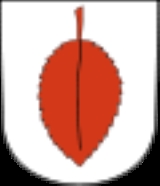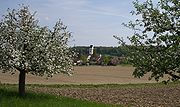
Ossingen
Encyclopedia
Ossingen is a municipality
in the district of Andelfingen
in the canton
of Zürich in Switzerland
.
 Ossingen has an area of 13.1 km² (5.1 sq mi). Of this area, 57.9% is used for agricultural purposes, while 30% is forested. Of the rest of the land, 7.9% is settled (buildings or roads) and the remainder (4.2%) is non-productive (rivers, glaciers or mountains).
Ossingen has an area of 13.1 km² (5.1 sq mi). Of this area, 57.9% is used for agricultural purposes, while 30% is forested. Of the rest of the land, 7.9% is settled (buildings or roads) and the remainder (4.2%) is non-productive (rivers, glaciers or mountains).
The municipality includes the village of Ossingen, the hamlets
of Weiler Burghof, Gisenhard, Hausen and Langenmoos, the farming settlements of Werdhof, Ziegelhütte and Dachsenhausen as well as Schloss Wyden (Widen Castle). It also includes the Husemersee
a lake located in the municipality.
In the 2007 election the most popular party was the SVP
which received 48.8% of the vote. The next three most popular parties were the SPS
(13.8%), the Green Party
(10.7%) and the FDP
(10.6%).
The age distribution of the population is children and teenagers (0–19 years old) make up 28.6% of the population, while adults (20–64 years old) make up 57.4% and seniors (over 64 years old) make up 14%. In Ossingen about 79% of the population (between age 25-64) have completed either non-mandatory upper secondary education or additional higher education (either university or a Fachhochschule
).
Ossingen has an unemployment rate of 1.22%. , there were 105 people employed in the primary economic sector and about 35 businesses involved in this sector. 79 people are employed in the secondary sector and there are 18 businesses in this sector. 193 people are employed in the tertiary sector, with 38 businesses in this sector.
The historical population is given in the following table:
Municipalities of Switzerland
Communes , also known as municipalities, are the smallest government division in Switzerland, numbering 2,596 . While many have a population of a few hundred citizens, the largest cities such as Zürich or Geneva also have the legal status of municipalities...
in the district of Andelfingen
Andelfingen (district)
Andelfingen District is one of the twelve districts of the German-speaking canton of Zurich, Switzerland.It corresponds to the Zürcher Weinland, bounded by the Rhine to the north and west, by the canton of Thurgau to the east, by Winterthur to the south and by the Irchel to the southwest.-...
in the canton
Cantons of Switzerland
The 26 cantons of Switzerland are the member states of the federal state of Switzerland. Each canton was a fully sovereign state with its own borders, army and currency from the Treaty of Westphalia until the establishment of the Swiss federal state in 1848...
of Zürich in Switzerland
Switzerland
Switzerland name of one of the Swiss cantons. ; ; ; or ), in its full name the Swiss Confederation , is a federal republic consisting of 26 cantons, with Bern as the seat of the federal authorities. The country is situated in Western Europe,Or Central Europe depending on the definition....
.
Geography

The municipality includes the village of Ossingen, the hamlets
Hamlet (place)
A hamlet is usually a rural settlement which is too small to be considered a village, though sometimes the word is used for a different sort of community. Historically, when a hamlet became large enough to justify building a church, it was then classified as a village...
of Weiler Burghof, Gisenhard, Hausen and Langenmoos, the farming settlements of Werdhof, Ziegelhütte and Dachsenhausen as well as Schloss Wyden (Widen Castle). It also includes the Husemersee
Husemersee
Husemersee is a lake at Ossingen in the Canton of Zurich, Switzerland. Its surface area is 8 ha.-External links: water quality*...
a lake located in the municipality.
Demographics
Ossingen has a population (as of ) of . , 7.0% of the population was made up of foreign nationals. Over the last 10 years the population has grown at a rate of 9.9%. Most of the population speaks German (94.7%), with Albanian being second most common ( 1.5%) and Italian being third ( 0.5%).In the 2007 election the most popular party was the SVP
Swiss People's Party
The Swiss People's Party , also known as the Democratic Union of the Centre , is a conservative political party in Switzerland. Chaired by Toni Brunner, but spearheaded by Christoph Blocher, the party is the largest party in the Federal Assembly, with 58 members of the National Council and 6 of...
which received 48.8% of the vote. The next three most popular parties were the SPS
Social Democratic Party of Switzerland
The Social Democratic Party of Switzerland is the largest centre-left political party in Switzerland....
(13.8%), the Green Party
Green Party of Switzerland
The Green Party of Switzerland is the fifth-largest party in the National Council of Switzerland, and the largest party that is not represented on the Federal Council.-History:...
(10.7%) and the FDP
Free Democratic Party of Switzerland
The Free Democratic Party was a classical liberal political party in Switzerland. It was one of the major parties in Switzerland until its merger with the smaller classical liberal Liberal Party, to form FDP.The Liberals on 1 January 2009....
(10.6%).
The age distribution of the population is children and teenagers (0–19 years old) make up 28.6% of the population, while adults (20–64 years old) make up 57.4% and seniors (over 64 years old) make up 14%. In Ossingen about 79% of the population (between age 25-64) have completed either non-mandatory upper secondary education or additional higher education (either university or a Fachhochschule
Fachhochschule
A Fachhochschule or University of Applied Sciences is a German type of tertiary education institution, sometimes specialized in certain topical areas . Fachhochschulen were founded in Germany and later adopted by Austria, Liechtenstein, Switzerland and Greece...
).
Ossingen has an unemployment rate of 1.22%. , there were 105 people employed in the primary economic sector and about 35 businesses involved in this sector. 79 people are employed in the secondary sector and there are 18 businesses in this sector. 193 people are employed in the tertiary sector, with 38 businesses in this sector.
The historical population is given in the following table:
| year | population |
|---|---|
| 15th Century | 330 |
| 1682 | 974 |
| 1850 | 1,198 |
| 1900 | 930 |
| 1950 | 805 |
| 2000 | 1,272 |

